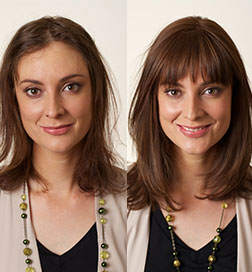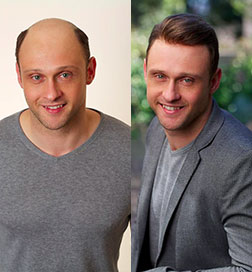
Hair transplants can be an excellent solution to overcome hair loss. They have come a long way from their genesis; a natural hairline and natural appearance of hair growing from the scalp is achievable today. The era of ‘barbie doll’ hair or a ‘row of trees’ hair is long gone!
However, hair transplants are probably the least popular hair loss treatment for women and the least advisable for regular female hair loss. There are three good reasons for this, and they each deserve serious consideration by any woman considering a hair transplant:
1. No Net Gain of Hair
Hair transplantation involves harvesting follicles from the back of the scalp and re-distributing or transferring them through thinning areas, which are typically the front and top regions of the scalp. No new hairs are created or added during this process. Rather, transplants deplete one source of hair (the back of the scalp) in order to create thickness in another. Most women find this concept to be undesirable.
Why is it undesirable? Most women want a significant increase in the number and quality of hair all over their scalp. Since hair transplants involve the relocation of existing hairs, they cannot achieve this. There is no net gain of hair and often the hairs that are relocated are of poor quality.
2. Poor Quality of existing hair – ‘the fine hair’ effect
Women rarely lose all their hair on top like men, but most do notice a significant change in the quality of their hair overall. Often their hair becomes finer in texture all over the entire head. This produces a wispy, ‘fly away’ effect that many are not happy with. It is often felt that this hair is of poor quality.
Relocating fine hair from one region to another area of thin hair will not change the quality of that hair, it will still be fine hair. Having more ‘poor’ quality hair will not re-create how their hair was originally (prior hair thinning), nor create the luxurious hair they are dreaming of. Other non-surgical hair restoration procedures such as Topettes, toppers or Sensi-graft CAN achieve these desirable results, and that is why these options are more frequently chosen over hair transplantation.
3. Transplants can increase Hair loss
Another important consideration is the potential for a hair transplant to cause further hair loss in the area of hair implantation. The region of hair that will receive the transplanted follicles is often an area of weak and fragile hair growth. The process of implanting hair into these regions has a high probability of causing trauma to the existing hair follicles and potentially causing hair mortality (or hair death). This may result a loss of existing hair follicles and create a situation of no net gain of hair follicles in the transplanted region. Ultimately, a hair transplant may be counterproductive to achieving the desired results.
In summary, the merits of hair transplants for women need to be carefully assessed to ensure they will accomplish the stated goals of the patient. It is our experience that transplants are not suitable for women with moderate hair loss. They simply cannot transplant enough hair to create the fuller, thicker hair a woman desires. Even though the newly transplanted hair may grow in those regions, it may be at the expense of the existing hair. Unfortunately, this may result in a zero sum gain in hair.




